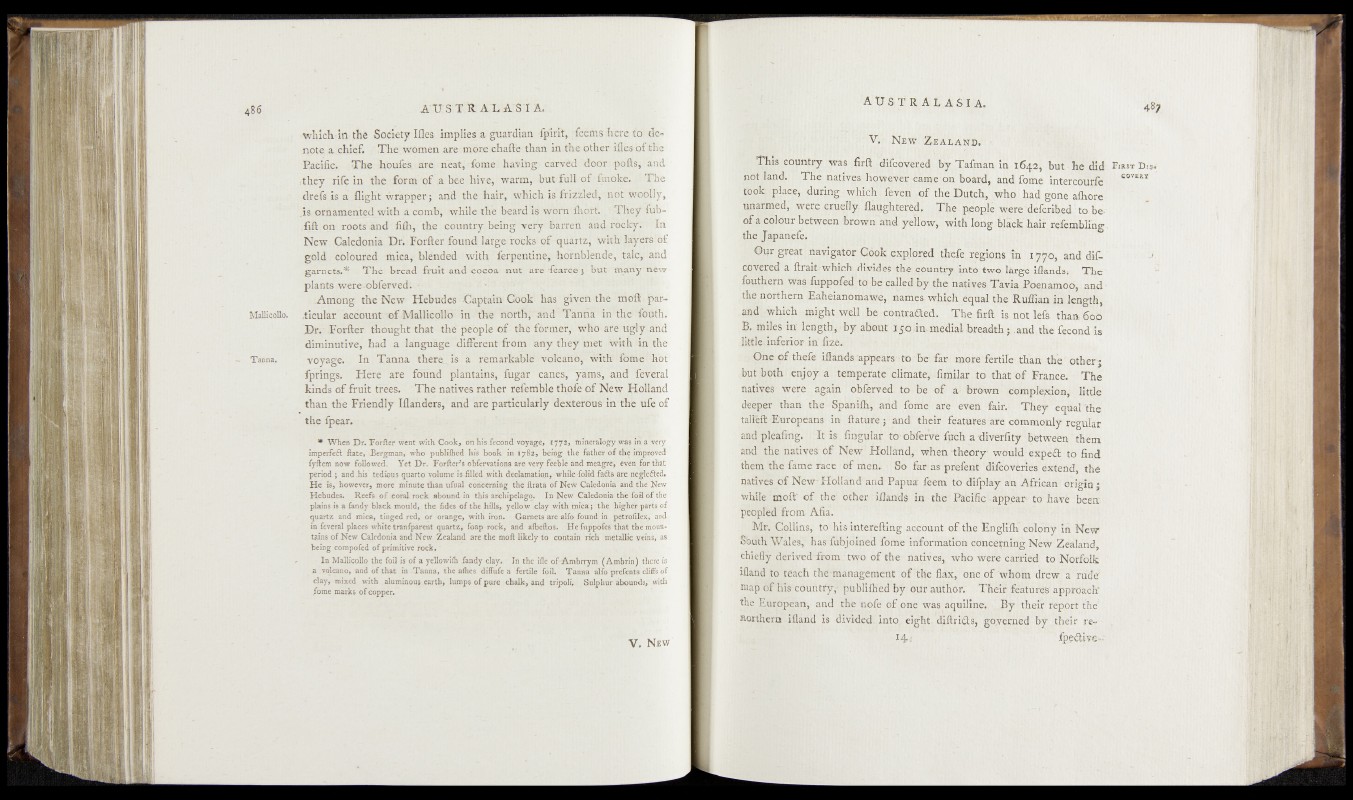
Malliçollo.
Tanna,
-whichin the Society Ifles implies: a guardian fplrit, rfeems faa-efoude-
note a chief, The „ women areJ more:eh aft'e than in ..the other ifles of lie
pacific. .The houfes, are neat, feme having’ carved door pofts, and
,theyrife in the form of .a bee hive, warm, but full of Imoke. The
drefs is a flight wrapper; and the hair, which is frizzled;, not woolly,
.is ornamented, with a comb, while the beard is worn ffioft. They fub-
.fift on roots and fifih, the country being very barren and rocky. In
New Caledonia Dr. Forfter found large rocks of quartz, with layers!of.
gold coloured mica,, blended - with Terpentine, hornblende, talc, and
garnets.* The bread fruit and cocoa nut are fcarce; but many n£w
plants were -obforved: -
.Among the New Hebudes Captain Cook has given the moll) par-
.ticukr accotmt’®f ;MalliGOllb in tli'e north, and Tkniia in the-fOuth.
.Dr. Forfter thought that thi’^ople of the former, who are ugly pid
diminutive, had a language different from any they -met -with in^the
voyage.. In Tanna ‘there. »- a remarkabi#’,v(MSM'€^i-' wftl^Rrfeeffiot
fprings. Here are found plantains, fugar Canes, "yafhs, and'fev’eral
kinds of fruit trees. The natives rather referable tKofe of New Holland
thatLthe Friendly Iflanders, and are particularly dexterous'in'thb ufe of
the Ijpear.
* When Dr. Forfter went with Cook, orihi's fecond voyage, 1772, mineralogy was in a very
imperfect fate, Bergman, who publifhed his book in.1782, being the father of. the improved
fyftem now followed. Yet Dr. Forfter’s dhfervation's are very feeble and meagre,1 even for that
period; and .his tedious quarto Volume is filled .with declamation, while folid faffs are neglefted.
He is, however, more minute than ufual concerning the ftrata of New Caledonia and the New
Hebudes. Reefs of coral rock abound in this archipelago. In New Caledonia the foil of the
plains is a fandy black mould, the tides of the hills, yellow .clay with mica; the higher parts of
quartz and mica, tinged red, or orange, with iron. Garnets are alfo found in petrofilex, and
in feveral places-white tranfparent quartz, foap-rock, and albedos. .: He fuppqfes that the mountains
of New Caledonia and New Zealand are the moft likely to contain rich metallic veins, ,as
being compofed of primitive’ rock.'
- - In Maliicollo the foil is of a yellowifh fandy clay. In the ille of Ambrrym (Ambrin) there is
a volcano, and of that in Tanna, the afhes diffufe a fertile foil. Tanna alfo prefents clifFs of
clay, mixed with aluminoup .earth, lumps of pure chalk, and tripoli. Sulphur abounds,' with
/ome marks of copper.
' ‘ V.' jNjÈffti ZEAiiAjfÈi' •'
Th^cppitry was firrf di&o^ ^(£ b y Tafman In 1642, but • hé cüd. Dis*
B°t Ja|id.||«|%4^ lea^d, an'd, fome intercomie* C0TE&*
had gone afbore- ’
unaiped,, were cruelly. fliughterèd The. .people wêké'defqribed |to beef
a colour between brown Wd yellow, with long hlackfiair refembling
tfie Japanefe.
Our great'navigator Cóok^^ploréd thefe re^kms^iii 1,790,. and dif- w
coveted a flxaitwHchjd^Hfis^iij^ij^tiy^jit^ tw-a IkrgeJftandsj The
fouthern was fuppofed^abepkjkdby the n a ^ v k T ^ j^ o e ^ n jo p , and’
tjie.northern Eaheianom'awe, names, which equal the Ruffian in length,
and which might WeU ,b^-pentrg;ae4. ftrffi is’h d tlff^ th a ^ lo p .
B. ffiiks irf length,--by about 150.in-medial breadth.;,, and the fecond-is
littlednferior in' fize.
;...One of thefe iftands appears to be far-- more fertile .than- the' other-;
butjbpth enjoy a-temperate'climatey'fimilar to thakOf’Ffknce;' The
natives' were again obferved to be of a* brown completion, little
deeper than the- Spamfhy and foir?éf aïe even fair. They ‘ eq&d "tlie
talleft-Europeans- in ftature; and their features’are commonly regulaï-
and-pleafmg. It is fmgu-laf to- obfervè ftrch a diverfity between them
and' the natives of New” Holland, when‘theory* wdul<F expse£b to find
thémthe fkme rkce of men.’ < So far - as jpréfèift' di&oVèra’ês ‘ éxt’erid; the
natives of New'Hblland’and Papua: ffiem to difplay an African' origin;
while moft” of the’ other iflands in the- Pacific - appear* tó'Êavé been
peopled from Afia.
Mr. Collins, to- hig- interefting account of the EtfgHffiVoIbfiy in New
South Wales, has fubjoined fome information cohcéijnipg New Zealand,
chiefly derived-from’tw'o of the natives^ whb Werfe/caffied' to-Norfolk
ïflahdjto teaqh thé-management of‘the flax, opeofyvhom drew a rude’
map of His-country,- publifhed by pur author. Their Features’ approach*
the European, and the nofe of one was aquiline. By their report the*
northern ifland is divided into, eight diftri£ts, governed by'it^eir re-- ,